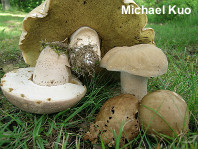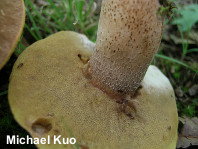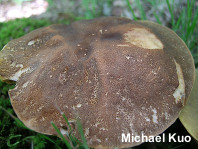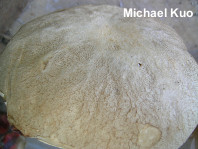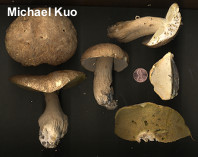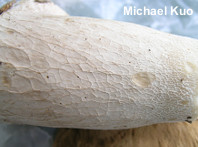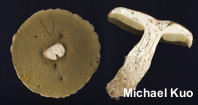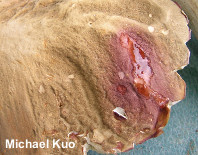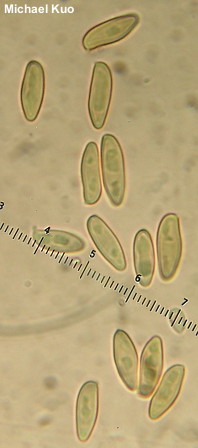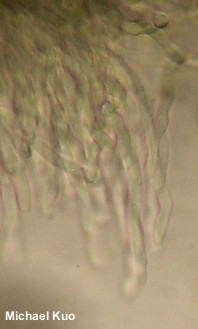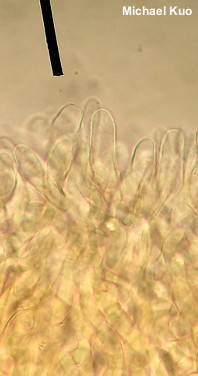| Major Groups > Boletes > Edulis Group > Boletus atkinsonii |

|
Boletus atkinsonii [ Basidiomycota > Boletales > Boletaceae > Boletus . . . ] by Michael Kuo This eastern member of the Boletus edulis species group is distinguished by its wrinkled cap surface (which becomes minutely patchy and fibrillose at maturity), its association with hardwoods, and the gorgeous purple reaction of its cap surface when a drop of ammonia is applied. Several species are very similar, including Boletus variipes, Boletus nobilis, and Boletus cf. reticulatus; see the Key to 14 North American edulis-like boletes for help separating them. I believe Boletus nobilissimus, described in 2000 from New York, is probably identical to Boletus atkinsonii (which was described from New York in 1904); the putative differences (whether the cap is wrinkled or not, whether the reticulation is "brownish" or white, and whether there are "tufts of roughened hyphae" on the cap surface) are all subject to variability—and, in the case of the "roughened hyphae," subject to the probable fallibility of an observation made by Smith & Thiers (1971) while studying a shellacked and pasted-to-cardboard type specimen from 1904. Description: Ecology: Mycorrhizal with oaks, beech, and other hardwoods; growing alone, scattered, or gregariously; summer and fall; widely distributed in eastern North America. The illustrated and described collections are from Illinois. Cap: 4–18 cm; convex at first, becoming broadly convex or almost flat; dry; bald when young, becoming finely roughened and fibrillose in places with maturity as the cuticle breaks apart and becomes finely cracked; often wrinkled and pocked when young; grayish brown to yellowish brown; often fading with age, sometimes to nearly buff. Pore Surface: White when young, becoming yellowish to olive yellow; not bruising; pores "stuffed" when young; at maturity with 2–3 angular pores per mm; tubes 5–13 mm deep. Stem: 5–12 cm long; 2–4 cm thick; club-shaped when young, becoming more or less equal, or with a slightly enlarged base; dry; solid; whitish or brownish; usually prominently reticulate with whitish to brownish reticulation that is fine-meshed toward the apex but more coarsely meshed below; basal mycelium white. Flesh: White; not staining when sliced. Odor and Taste: Not distinctive. Chemical Reactions: Ammonia purplish to pinkish purple or magenta on cap surface; negative on flesh. KOH negative to orangish on cap surface—sometimes flashing purplish first; negative on flesh. Iron salts negative to greenish on cap surface; negative on flesh. Spore Print: Yellowish brown. Microscopic Features: Spores 10–15 x 3–4.5 µm; fusiform; smooth; hyaline to yellowish in KOH. Basidia 4-sterigmate. Cheilocystidia abundant in buttons (when pore surface is still "stuffed"); 75–100 x 2–5 µm; cylindric-flexuous; with rounded apices; by maturity often collapsed. Pleurocystidia not found. Pileipellis a tightly packed trichoderm; hyaline to yellow-brown in KOH; elements 2.5–7.5 µm wide, smooth or rarely appearing somewhat roughened due to collapse of the cell wall; terminal cells cylindric with rounded or subclavate apices. REFERENCES: Peck, 1904. (Saccardo, 1912; Snell & Dick, 1970; Smith & Thiers, 1971; Both, 1993; Bessette, Roody & Bessette, 2000; Kuo & Methven, 2014.) Herb. Kuo 07309701, 07220321, 09190302, 06300711, 07060702, 06230902, 06031010. This site contains no information about the edibility or toxicity of mushrooms. |
© MushroomExpert.Com |
|
Cite this page as: Kuo, M. (2017, May). Boletus atkinsonii. Retrieved from the MushroomExpert.Com Web site: http://www.mushroomexpert.com/boletus_atkinsonii.html |
